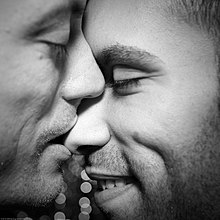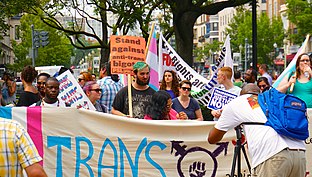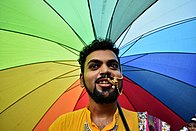LGBT culture
The examples and perspective in this article deal primarily with North America and do not represent a worldwide view of the subject. (November 2021) |

| Part of a series on |
| LGBT topics |
|---|
|
t |
LGBT culture is a culture shared by lesbian, gay, bisexual, transgender, and queer individuals. It is sometimes referred to as queer culture (indicating people who are queer), while the term gay culture may be used to mean either "LGBT culture" or homosexual culture specifically.
LGBT culture varies widely by geography and the identity of the participants. Elements common to cultures of gay, lesbian, bisexual, transgender, and intersex people include:
- Works by famous gay, lesbian, bisexual, and transgenderpeople, including:
- Contemporary LGBT artists and political figures like Larry Kramer, Keith Haring and Rosa von Praunheim.
- Historical figures identified as LGBT, although identifying historical figures with modern terms for sexual identity is controversial (see History of sexuality). However, many LGBT people feel a kinship with these people and their work (particularly that addressing same-sex attraction or gender identity); an example is VictoryFund.org, dedicated to supporting homosexual politicians.
- An understanding of LGBT social movements
- Figures and identities present in the rainbow flag.
- Madonna stated, "I was asked to perform at many Pride events around the world—but I would never, ever turn down New York City."[4]
Not all LGBT people identify with LGBT culture; this may be due to geographic distance, unawareness of the subculture's existence, fear of social stigma or a preference for remaining unidentified with sexuality- or gender-based subcultures or communities. The Queercore and Gay Shame movements critique what they see as the commercialization and self-imposed "ghettoization" of LGBT culture.[5][6]
In some cities, particularly in
Gay men's culture
According to Herdt, "homosexuality" was the main term used until the late 1950s and early 1960s; after that, a new "gay" culture emerged. "This new gay culture increasingly marks a full spectrum of social life: not only same-sex desires but gay selves, gay neighbors, and gay social practices that are distinctive of our affluent, postindustrial society".[9]
During the 19th and early 20th centuries, gay culture was largely underground or coded, relying on in-group symbols and codes woven into ostensibly
After the 1969
In 1980 a group of seven gay men formed
Female celebrities such as Liza Minnelli, Jane Fonda, and Bette Midler spent a significant amount of their social time with urban gay men (who were now popularly viewed as sophisticated and stylish by the jet set), and more male celebrities (such as Andy Warhol) were open about their relationships. Such openness was still limited to the largest and most progressive urban areas (such as New York City, San Francisco, Los Angeles, Boston, Philadelphia, Seattle, Chicago, Dallas, Houston, Atlanta, Miami, Washington, D.C., and New Orleans), however, until AIDS forced several popular celebrities out of the closet due to their illness with what was known at first as the "gay cancer".[11]
Elements identified more closely with gay men than with other groups include:
- Pop-culture Madonna, Mariah Carey, Beyoncé, Judy Garland, Cher, Donna Summer, Lady Gaga, Kesha, Kylie Minogue, and Diana Ross)
- Familiarity with aspects of romantic, sexual and social life common among gay men (for example, LGBTQ+ culture—"evening people")[12]
- physique magazinesand fitness culture
There are a number of subcultures within gay male culture, such as
Relationships

Some U.S. studies have found that the majority of gay male couples are in
During the 1980s and 1990s, Sean Martin drew a comic strip (
An Australian study conducted by Roffee and Waling in 2016 discovered how some gay men felt like they were expected to be hyper-sexual. Participants reported how other gay men would automatically assume that any interaction had sexual motivations. Furthermore, if it was then clarified that this is not the case then these gay men would suddenly feel excluded and ignored by the other gay men with which they had been interacting with. They felt that they could not obtain purely platonic friendships with other gay men. One participant reported feeling alienated and disregarded as a person if they were not deemed by other gay men as sexually attractive. This presumption and attitude of hypersexuality is damaging, for it enforces preconceived ideals upon people, who are then ostracised if they do not meet these ideals.[16]
Online culture and communities
A number of online social websites for gay men have been established. Initially, these concentrated on sexual contact or titillation; typically, users were afforded a profile page, access to other members' pages, member-to-member messaging and instant-message chat. Smaller, more densely connected websites concentrating on social networking without a focus on sexual contact have been established. Some forbid all explicit sexual content; others do not.[17] A gay-oriented retail online couponing site has also been established.[18]
Recent research suggests that gay men primarily make sense of familial and religious challenges by developing online peer supports (i.e., families of choice) in contrast to their family allies' focus on strengthening existing family of origin relationships via online information exchanges. Participants' reported online sociorelational benefits largely contradict recent research indicating that online use may lead to negative mental health outcomes.[19]
Fashion
Notable gay and bisexual fashion designers include Giorgio Armani, Kenneth Nicholson, Alessandro Trincone, Ludovic de Saint Sernin, Patrick Church, Gianni Versace, Prabal Gurung, Michael Kors and others are among the LGBT fashion designers across the globe.[20]
Lesbian culture

As with gay men, lesbian culture includes elements from the larger LGBTQ+ culture, as well as other elements specific to the lesbian community. Pre-Stonewall organizations that advocated for lesbian rights, and provided networking opportunities for lesbians, included the Daughters of Bilitis, formed in San Francisco in 1955. Members held public demonstrations, spoke to the media, and published a newsletter.
Primarily associated with lesbians in North America, Europe, Australia, and New Zealand, lesbian culture has often involved large, predominantly lesbian "women's" events such as the
1950's and early '60s stereotypes of lesbian women stressed a binary of "butch" women, or
Bisexual culture

Bisexual culture emphasizes opposition to, or disregard of, fixed
Many bisexual, fluid, and pansexual people consider themselves to be part of the
The
Transgender culture

The study of transgender and transsexual culture is complicated by the many ways in which cultures deal with sexual identity/sexual orientation and gender. For example, in many cultures people who are attracted to people of the same sex—that is, those who in contemporary Western culture would identify as gay, lesbian or bisexual—are classed as a third gender with people who would (in the West) be classified as transgender.
In the contemporary West there are different groups of transgender and transsexual people, such as groups for transsexual people who want
Some transgender or transsexual women and men, however, do not identify as part of a specific "trans" culture. A distinction may be made between transgender and transsexual people who make their past known to others and those who wish to live according to their gender identity and not reveal their past (believing that they should be able to live normally in their true gender role, and control to whom they reveal their past).[36]
According to a study done by the Williams Institute of UCLA on "How Many Adults Identify as Transgender in the United States?",[37] they found that younger adults are more likely to identify as transgender than older adults. This may be a result of a newly wider acceptance of transgender people from the communities, allowing for those who identify as transgender to have a greater voice. In their research they found that an estimated 0.7% of adults between the ages of 18 and 24 identify as transgender, while 0.6% of adults age 25 to 64 and 0.5% of adults age 65 or older identify as transgender.
The pink on the transgender pride flag represents female while the baby blue on the flag represents male. The white stripe in between the baby blue and pink represents other genders besides male or female.[38]
Transgender relationships
In the report "Views from both sides of the bridge? Gender, sexual legitimacy, and transgender people's experiences of relationships", authors Iantaffi and Bockting conducted a study with 1229 transgender individuals over 18 years old, to learn more about transgender relationships in the US. When it came to a relationships within a transgender person, it depended on if they wanted a heteronormative or mainstream culture relationship. Studies show transgender people can also be victim to heteronormativity too, and it can impact their relationships. There are also transgender people that try to challenge Western traditional beliefs in gender roles and sexual differences within relationships.[39]
Events

Many annual events are observed by the transgender community. One of the most widely observed is the Transgender Day of Remembrance (TDOR) which is held every year on November 20 in honor of Rita Hester, who was killed on November 28, 1998, in an anti-transgender hate crime. TDOR serves a number of purposes:
- it memorializes all of those who have been victims of hate crimes and prejudice
- it raises awareness about hate crimes towards the transgender community
- and it honors the dead and their relatives[40]
Related events are the trans marches, a series of annual marches, protests or gatherings that take place around the world, often during the time of the local pride week. These events are frequently organized by transgender communities to build community, address human rights struggles, and create visibility.
Youth culture
This article may contain an excessive amount of intricate detail that may interest only a particular audience. |
Gay and lesbian youth have increased risks for suicide, substance abuse, school problems and isolation because of a "hostile and condemning environment, verbal and physical abuse, rejection and isolation from family and peers", according to a U.S. Task Force on Youth Suicide report.[45] Further, LGBTQ+ youths are more likely to report psychological and physical abuse by parents or caretakers, and more sexual abuse. Suggested reasons for this disparity are:
- youths may be specifically targeted on the basis of their perceived sexual orientationor gender non-conforming appearance.
- "...Risk factors associated with sexual minority status, including discrimination, invisibility, and rejection by family members...may lead to an increase in behaviors that are associated with risk for victimization, such as substance abuse, sex with multiple partners, or running away from home as a teenager."[46]
A 2008 study showed a correlation between the degree of parental rejection of LGB adolescents and negative health problems in the teenagers studied.
Increasing mainstream acceptance of the LGBTQ+ communities prompted the Massachusetts Governor's Commission on Gay and Lesbian Youth to begin an annual Gay–Straight Youth Pride observance in 1995.[41][50] In 1997 the nonprofit Youth Pride Alliance, a coalition of 25 youth-support and advocacy groups, was founded to hold an annual youth-pride event in Washington, D.C.;[51] Candace Gingrich was a speaker the following year.[52] In 1999, the first annual Vermont Youth Pride Day was held. As of 2009 it is the largest queer and allied-youth event in Vermont, organized by Outright Vermont to "break the geographic and social barriers gay youngsters living in rural communities face."[53] In 2002, a college fair was added to the event to connect students with colleges and discuss student safety.[54] In April 2003 a Youth Pride Chorus, organized with New York's LGBT Community Center, began rehearsals and later performed at a June Carnegie Hall Pride concert with the New York City Gay Men's Chorus.[55]
In 2004 the San Diego chapter of
LGBT youth are more likely to be homeless than heterosexual, cisgender youth due to the rejection from their parents because of their sexual orientation, or gender identity (Choi et al., 2015; Durso and Gates, 2012; Mallon, 1992; Whitbeck et al., 2004). Out of the 1.6 million homeless people in the United States, forty percent of them identify as part of the LGBT community.[64] In a survey of street outreach programs 7% of the youth were transgender (Whitbeck, Lazoritz, Crawford, & Hautala, 2014). Many of the transgender youth that are placed in homeless shelters do not get the type of help they need and often experience discrimination and systemic barriers that include sex-segregated programs in institutional practices that refuse to understand their gender. Many transgender youths have problems acquiring shelters because of certain policies like binary gender rules, dress codes, and room assignments (Thaler et al., 2009). Problems with classification happen when the procedures or policies of a shelter require the youth to be segregated based on their assigned sex rather than what they classify themselves as. As a result, many of the LGBT youth end up on the street instead of shelters which are meant to protect them.[65]
LGBT youth also have a higher suicide rate in the U.S. Those who identify with the LGBT community are four times as likely to attempt suicide than those who do not.[66] There was a study that was done to look into the difference of rates between gay high school students and their straight peers. They were asked about their sexual orientation and then about suicide. They found that about 32 percent of sexual minorities (Lesbian, Gay, Bisexual) had suicidal thoughts in comparison to almost 9.5 percent of their heterosexual peers.[66]
LGBT population estimates by country
| Country | LGBT population estimates |
|---|---|
| 40,000,000–70,000,000[67][68] | |
| 2,500,000–70,000,000[69][70] | |
| 20,000,000–30,000,000[71][72] | |
| 12,700,000[73] | |
| 8,000,000–20,000,000[74][75] | |
| 6,900,000–10,400,000[76] | |
| 7,100,000[77] | |
| 6,000,000[78] | |
| 4,900,000[79] | |
| 4,700,000[80] | |
| 4,600,000[81] | |
| 3,600,000-4,900,000[82][83] | |
| 3,600,000[84] | |
| 3,500,000-4,400,000[85][86] | |
| 3,400,000[87] | |
| 2,600,000[88] | |
| 2,500,000[89] | |
| 2,200,000[90] | |
| 2,100,000[91] | |
| 1,500,000[92] | |
| 1,400,000[93] | |
| 1,300,000[94] |
Pride
Gay pride and Pride parade
 LGBT parades are outdoor events celebrating LGBT social and self acceptance, achievements and legal rights. Other LGBT culturesSeveral other segments of the LGBTQ+ community have their own communities and cultures. African-American LGBT culture In the United States and Europe, some cities host black gay pride events with a focus on celebrating the black gay community and culture. The two largest in the world are Atlanta Black Pride and D.C. Black Pride. UK Black Pride is the largest celebration of its kind outside the U.S. Movements and politics LGBT social movements are social movements that advocate for LGBT people in society. Social movements may focus on equal rights, such as the 2000s movement for marriage equality, or they may focus on liberation, as in the gay liberation movement of the 1960s and 1970s.
LGBT conservatism is a socio-political movement which embraces and promotes the ideology of conservatism within an LGBT context. LGBT culture in the military In 2010, the repeal of the Don't Ask Don't Tell (DADT)[95] was a great step in the inclusion of lesbian, gay, and bisexual individuals in the military. "The repeal of DADT reversed the practice of discharging LGB service members on the basis of sexual identity." Although this was a large shift in policy by the U.S. for those identifying as LGB, those who are transgender are still not fully included in this change.
CriticismCriticism of LGBT culture comes from a variety of sources, much of which is critique from within the community itself. Some, like Michael Musto, view the culture as conforming to caricatures or stereotypes that alienate "fringe" members of the community. Mattilda Bernstein Sycamore and movements like Gay Shame have argued that LGBT culture has been depoliticized by a tiny minority of relatively privileged queer people, who participate in "institutions of oppression" at the expense of the vast majority of LGBT people.[97] Some consider the very notion of "separatism", or a group lifestyle, alienating (including of LGBTQ+ members in the broader society).[citation needed] Another problem is that bisexual and transsexual/transgender individuals experience social pressure to identify as gay or lesbian, and may face ostracism and discrimination from the mainstream LGBTQ+ culture. For bisexuals, this pressure is known as bisexual erasure. New York University School of Law professor Kenji Yoshino has written, "Gays de-legitimatize bisexuals...the lesbian and gay community abounds with negative images of bisexuals as fence-sitters, traitors, cop-outs, closet cases, people whose primary goal in life is to retain 'heterosexual privilege'".[98]
Identity politicsCriticism has been made that the LGBT community represents an artificial separation, rather than one based on tangible customs or ethnic identification. In particular, labels that LGBT members use to describe themselves vary widely; some simply prefer to identify as loving a particular gender. Some believe that the LGBT-community concept is alienating; the term itself implies estrangement from straight people as a separate group. Further, including three groups involved with sexuality and one group exploring transsexual/transgender identity (a broader phenomenon) is artificial.[99] Mattilda Berstein Sycamore argues that the single-issue focus of LGBT politics, which ignores all intra-group differences, has naturally led to a movement and culture focused on the needs of white, middle-class gay cisgender men, which alienates anyone who does not fit that description.[97] Cultural focus on promiscuitySome gay male commentators who are in monogamous relationships argue that mainstream gay culture's disdain of monogamy and its promotion of promiscuity has harmed efforts to legalize same-sex marriage.[100] Yuvraj Joshi argues that efforts to legalize same-sex marriage have emphasized the sameness of gay people to heterosexuals, while privatizing their queer differences.[101] RacismBritish journalist Time Out New York wrote that "Thank fucking God someone did this, because...whatever happened to our individuality, our differences?" Other commentators harshly criticized Simpson's argument, with Boyz declaring that "Simpson is a cunt."[102]
See also
References
Further reading
External links
|




